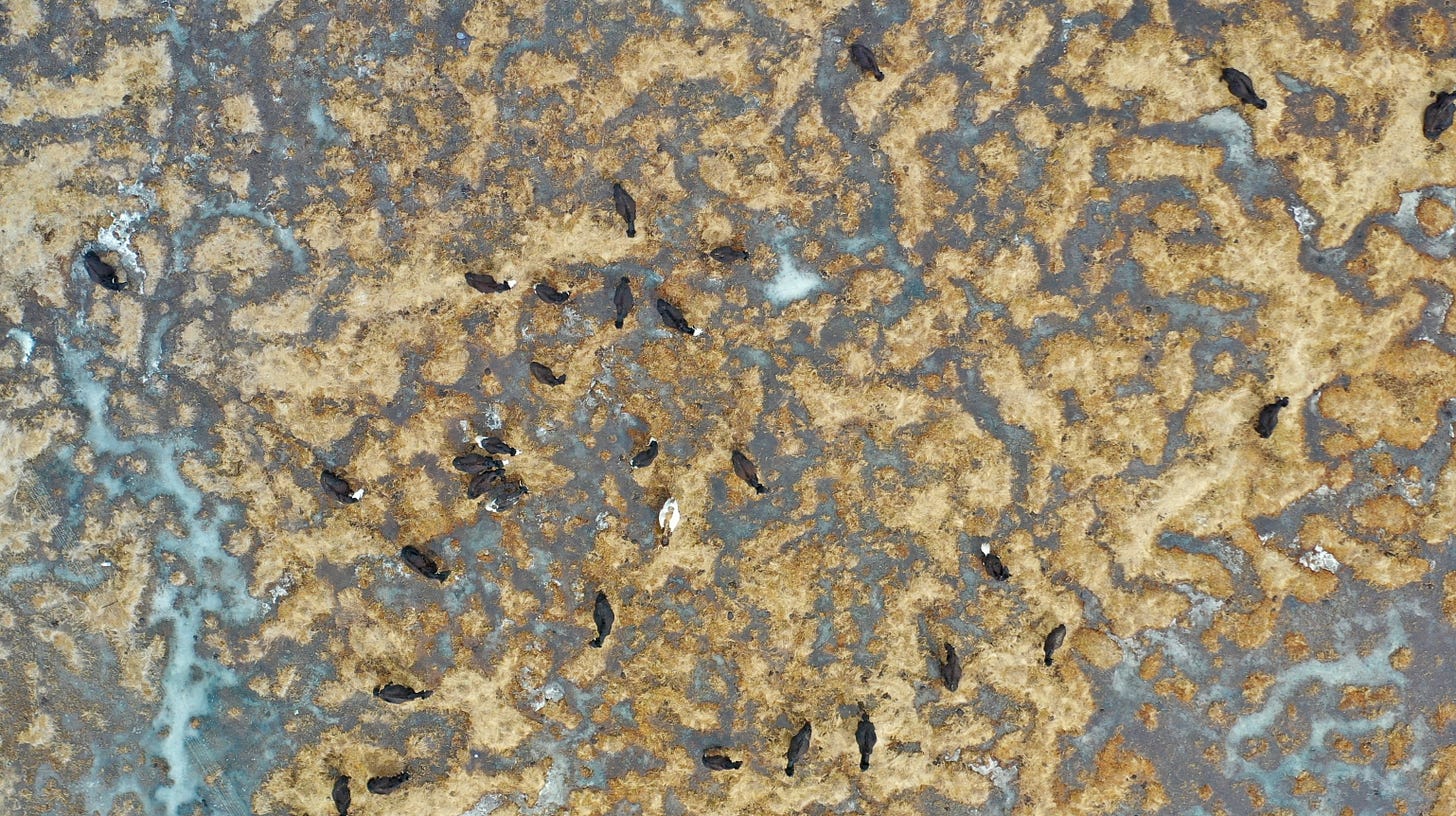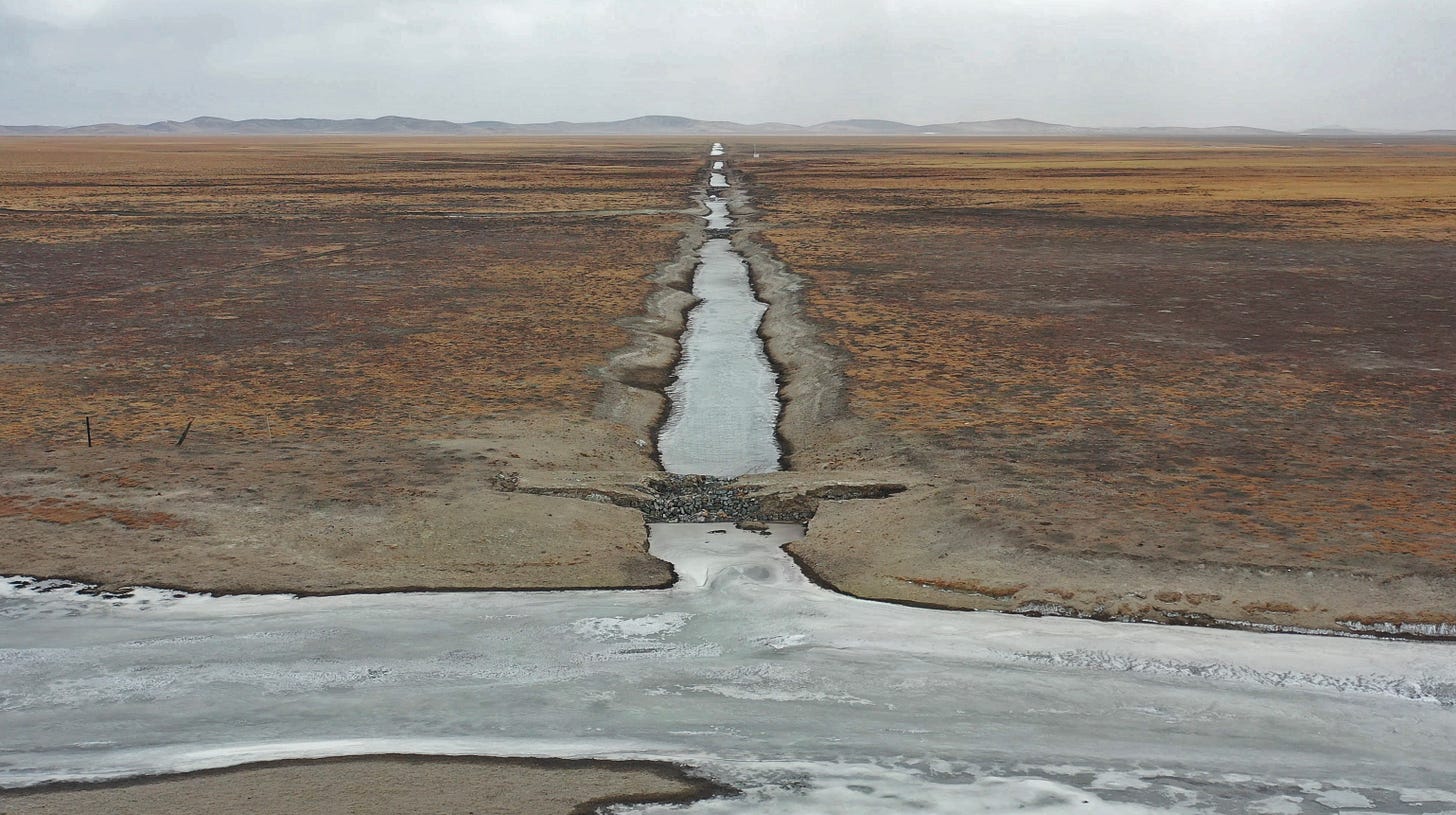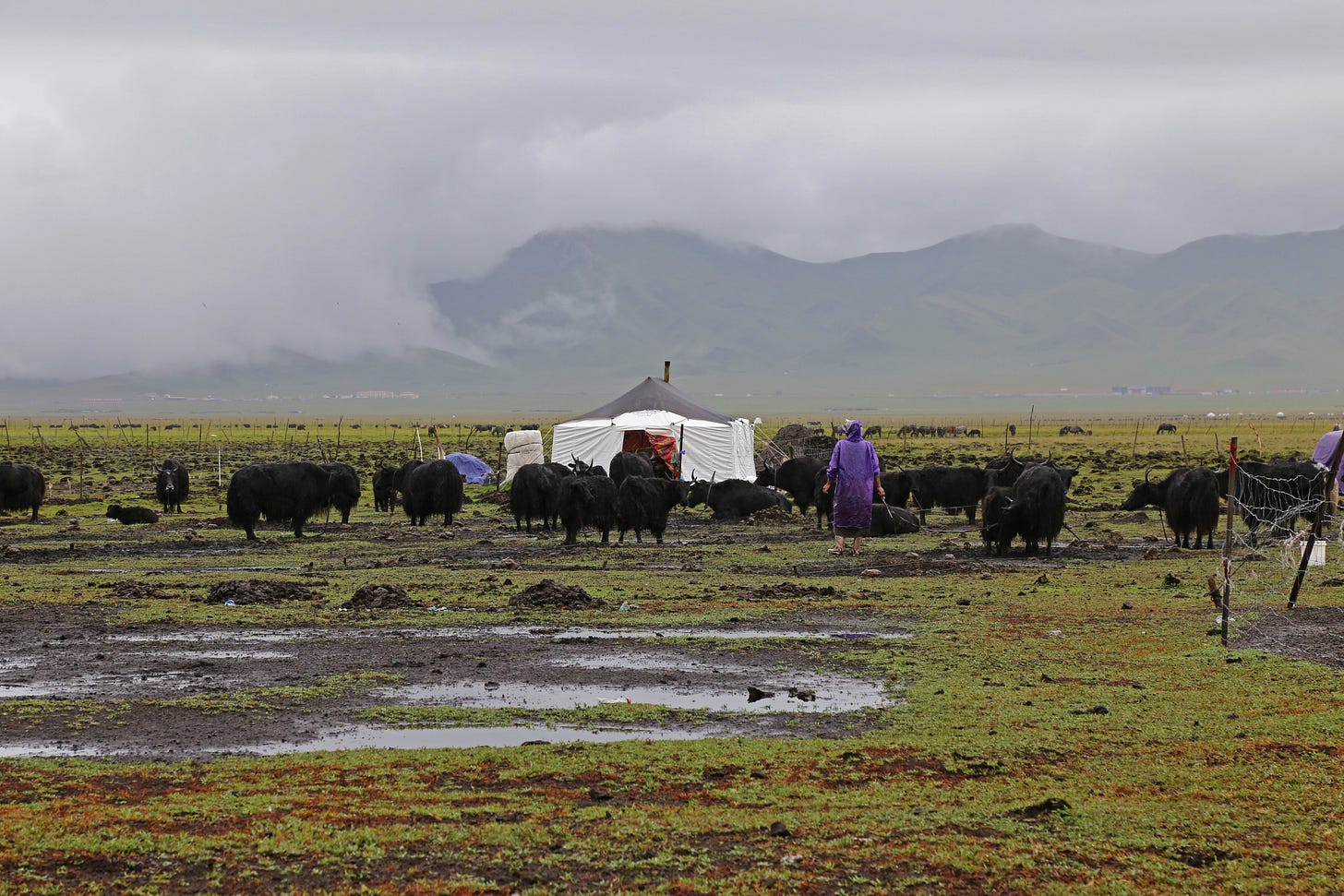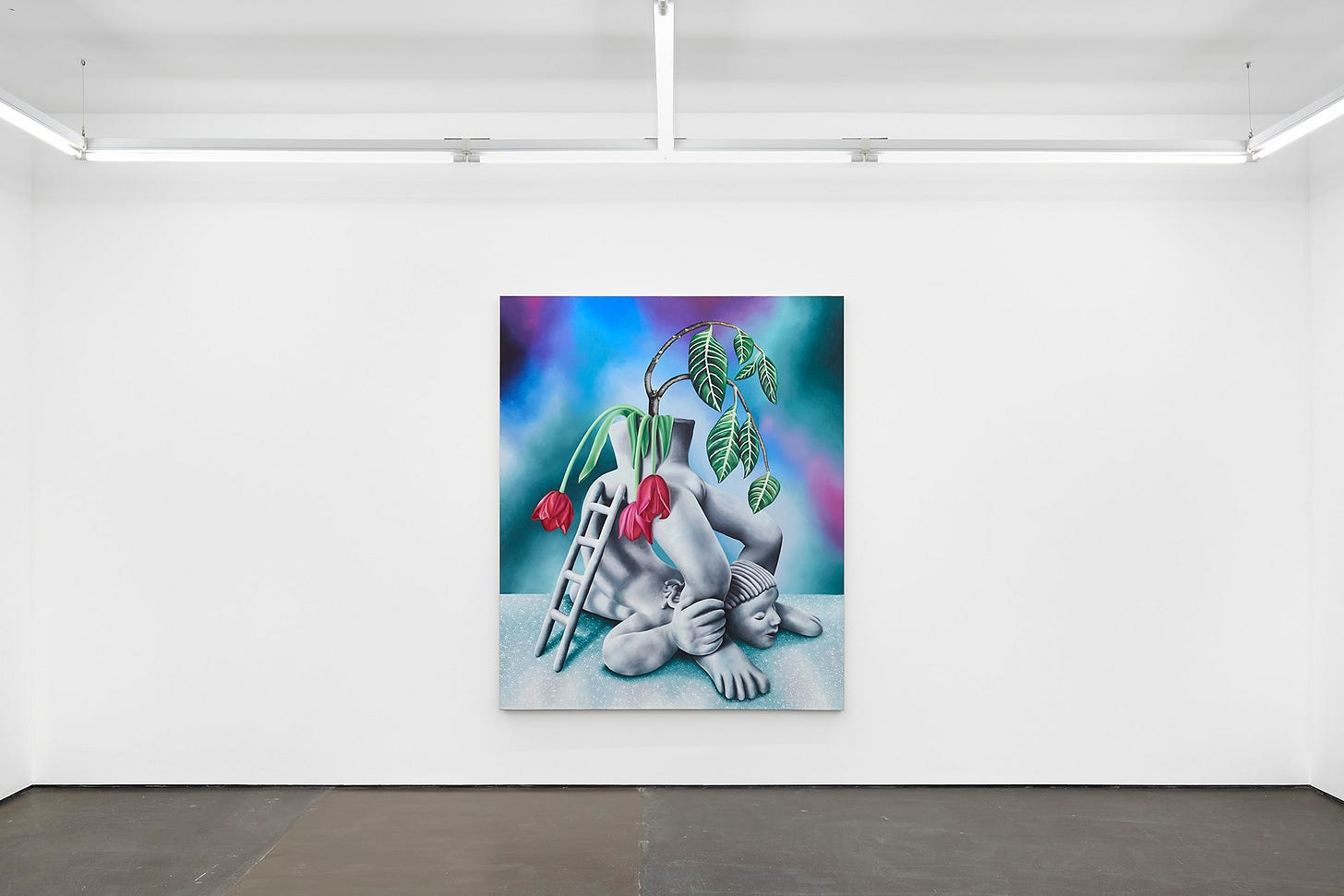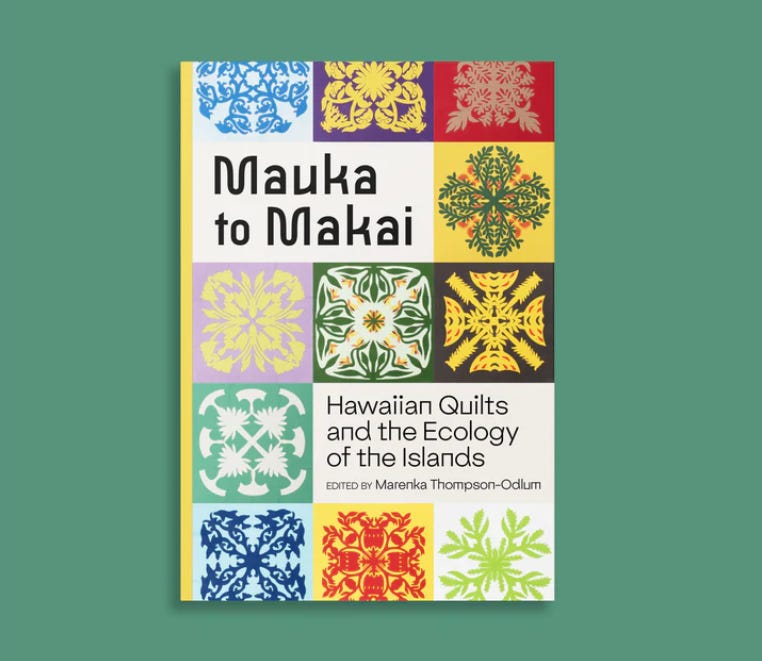Better Butter
Ecologies of yak butter with Mingxin Li | Spotlight on Jane Hayes Greenwood | Unfurling leaves: Hawaiian quilts | In the mycelium...
Yaks in wetland pasture, February 2024, Aerial footage by Mingxin Li
For some nomadic Tibetan societies living on the Zoige plateau, yak herding is not just an occupation but a holistic way of life. Within these cultures and in this unique landscape, yak, human, and environment are inextricably entwined within a finely balanced set of reciprocal care relations – an equilibrium which is now being threatened in myriad ways.
In traditional herder families, the yaks’ coarse outer wool is woven into tents and blankets, while the finer wool is used for thermal layers. Yak hide boats were traditionally used to cross rivers, while the powerful animals can carry possessions between encampments, where dried dung can be used to fuel cooking stoves. Both yak meat and milk are densely caloric, and the latter is churned into butter, used to preserve the milk and to make the bitter yak-butter tea herders drink to energise themselves in cold temperatures and high altitudes. The yak is also at the heart of many social and spiritual practices, for example through torma, the yak-butter sculptures used in Tibetan Buddhist rituals and offerings.
In a rich cyclical set of interrelations, yaks, humans, and landscape have evolved in dialogue with one another for centuries. The Zoige plateau is a 27,000 sq km wetland area sitting at the head of China’s two largest rivers, the Yellow and Yangtze. It is characterised by peat bogs up to 10 metres thick, making it a huge carbon store and a site of distinctive biodiversity. This is a landscape sculpted by yaks, which have been herded by Indigenous communities here for thousands of years.
Ditches in northern Zoige Marsh, February 2024, Drone footage, Mingxin Li
However, in the 1960s and 1970s, extensive drainage ditches were dug to dry out the bogs to create grazing pasture, throwing the area into a spiral of ecological crisis. Desertification and erosion made the project a failure, not only damaging the Zoige’s biodiversity and yak herding practices, but also severely affecting water supply in China’s largest rivers. Drainage was only stopped at the turn of the century, and it is only in the last two decades that restoration efforts have begun, plugging drains and rewetting the bogs. However, the place of yak herding communities within this restoration remains uncertain.
For RCA architecture PhD researcher Mingxin Li, yak butter provides “a crucial knot to connect humans and more-than-human beings” in this complex eco-cultural context. His current project Golden Butter, Golden Motherland has recently been awarded the 2024 Food Action Award (emerging practice) funded by CLIMAVORE X Jameel at RCA, an award for arts projects aiming towards building alternative diets that benefit human and nonhuman nourishing in the context of the climate crisis. Mingxin Li’s project looks to address the disappearance of the yak herding wetlands in Tibet, aiming to reactivate ancestral food and pastoralist knowledge between generations.
On his recent field trips, Mingxin lived with a herder family for a month, labouring with them and sleeping under their roof. He felt it was important to learn herder practices through building mutual trust and care. He says that “the problem of yak butter emerged in a discussion with Zhake, an experienced herder and former village leader. He felt that the taste of yak butter had softened, and its colour had become whiter than forty years ago. He also believed the reason for these changes was land degradation, water and vegetation loss.”
Yak butter produced inNovember, March 2024, Photo by Zhala Daji
“For the local family I collaborated with, their common summer pastureland is a wetland affected by water loss,” he explains. “This means a water shortage and poor grass growth. These two factors directly affect yaks' physique and milk, affecting the butter made from yak milk.” At the same time, “the eating of yak butter is marginalised by food commodities produced and transported from outside Zoige, which are convenient and provide richer flavour.” As well as ecocidal environmental policies, materialised and secularised discourses are being imposed on herders: “These challenges threaten the sustainability of traditional yak herding practices and the cultural-ecological knowledge embedded within them.”
In particular, Mingxin found that younger generations of herders were consuming much less yak butter, instead choosing mass-produced options that have fewer health benefits and come in polluting packaging. He therefore realised, in collaboration with other herders, that “the yak butter is at the intersection of wetland degradation, food heritage loss, and local know-how involved in yak-butter practice.”
Tying yaks in summer common pastures, Zoige Marsh, August 2023, Photo by Mingxin Li
His project Golden Butter, Golden Motherland centres on participatory action with local Tibetans of different ages. “I proposed collective practices such as yak butter tasting and medical herb collection, which aim to create space and time for local people to re-learn their own knowledge, especially young generations.” Through a mutually developed “yak-butter-knotted practice”, he hopes to help “reclaim and transmit ancestral knowledge between generations” as well as fostering “new knowledge production to face ongoing and future environmental crises.”
He goes on to explain that “the project has the potential to expand both locally and internationally by highlighting the interconnectedness of cultural and ecological systems in pastoralist communities and drained wetlands. There are clear parallels with other regions where pastoralist knowledge and practices are being eroded by political, economic, and environmental pressures, such as the Mongolian steppes, and pastoralist communities in Africa and South America. By sharing methodologies and insights from our project, we can hope to foster a global network of communities working to reclaim and sustain their indigenous knowledge and practices.”
Follow @mingxin_lii | Website
Spotlight on… Jane Hayes Greenwood
Jane Hayes Greenwood, The Contortionist, 2023. Oil on linen, 180 x 160cm. Installation view, Jane Hayes Greenwood: A Little History, Castor Gallery, 22 June - 29 July 2023.
Jane Hayes Greenwood is first and foremost a painter but works across painting, ceramics, sculptural installation and CGI animation. Beginning with an autobiographical starting point, her work reflects on universal subjects such as birth, death, and the erotic. In her work, otherworldly plants and strange objects exist in psychologically charged, psychedelic environments. Infused with a dreamlike sensibility, her work explores the powerful connections between the human and un/natural world. Paintings such as “The Contortionist” speak to the transformational and related experiences of motherhood and mourning, while also suggesting a radical plant-human hybridity indicating both the psychological weight with which we imbue plants and our fundamental cross-species dependence on them.
Jane is currently in the process of curating a large group show for Castor Gallery that opens at the end of August 2024 at Castor Gallery. The exhibition, The Nature of Things, brings together artists exploring the thingliness of nature and the nature of things. Works in the exhibition query the distinction between the natural world and human culture; touch on ancient and indigenous knowledge and ecology; consider our shifting relationships and changing bonds with the vegetal world; tell stories of displacement and violence; and move from the mystical to the comical.
Follow @janehayesgr | Website
Unfurling leaves
Mauka to Makai: Hawaiian Quilts and the Ecology of the Islands
Edited by Marenka Thompson-Odlum | Common Threads Press
Exploring the intimate relationship between Hawaiian quilts, post-colonialism and ecological disaster, research curator Marenka Thompson-Odlum traverses Hawai‘i through the Poakalani quilting group, who have worked since 1972 to preserve the cultural legacy of Hawai‘i’s quilting tradition. The ahupua‘a is an ancient land division system — extending from the highest regions of Hawai‘i’s uplands (mauka) to the ocean (makai) — representative of the Hawaiian people's sacred knowledge and reverence towards the environment. Once a thriving and finely balanced system, the colonisation of the Hawaiian Islands coupled with the existential threat posed by the climate crisis has put the ahupua‘a severely at risk. Published by Common Threads Press, Mauka to Makai pulls on the threads of connectivity shared by those who are using Indigenous Hawaiian philosophies of sustainable stewardship to revitalise the ahupua‘a.
In the mycelium…
Kotryna Ula Kiliulyte: Arctic Swell: a simple melody, Street Level Photoworks, Glasgow | until 4 August 2024
Take a Breath, IMMA, Dublin | until 16 Mar 2025
Otobong Nkanga: We Come from Fire and Return to Fire, Lisson Gallery, London | until 3 August 2024
Invasion Ecology: online conversations | Tuesdays, 2 July - 30 July
Daniel & Clara: The Lost Estate, Norwich Castle Museum & Art Gallery | until 12 Jan 2025
A Gathering on Art and Land, Event, Serpentine Pavilion, London | Saturday 13 July 2024, 11am - 5.30pm
MA Art & Ecology degree show, Goldsmiths University, London | 12 - 16 July 2024
This newsletter is free for now…
…but in the future I hope to turn on paid subscriptions to make it sustainable for me. In the meantime, I’d love to hear any feedback and whether you might be happy to upgrade to a paid tier in the future!



